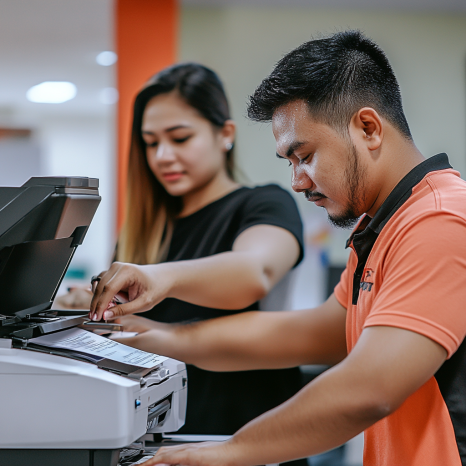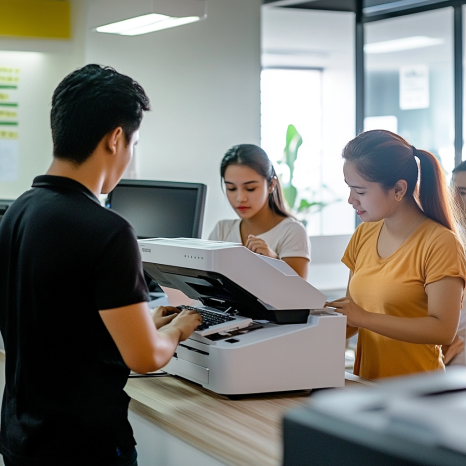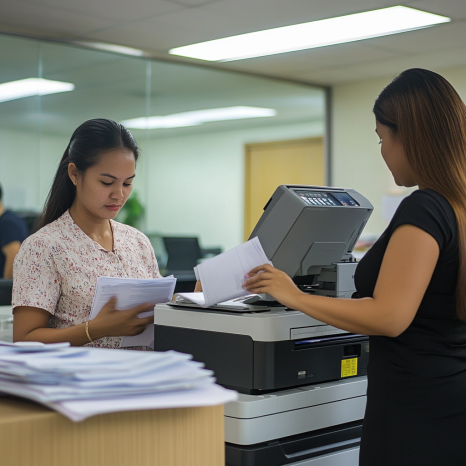
Setting Up a Home Office Printer
Setting Up a Home Office Printer
Setting Up a Home Office Printer: The rise of remote work has made having a functional home office essential for professionals across industries. One of the most important pieces of equipment in any home office is a printer. Whether you’re printing documents for work, school, or personal use, a reliable printer can significantly boost productivity. In this blog, we’ll dive deep into the considerations for setting up a home office printer, from printer rental options to sustainability, legal factors, and practical cost-saving tips.
What is a Printer Rental?
A printer rental is a service where businesses can lease printers for a specific time, typically ranging from days to several months. This allows companies and event organizers to access high-quality printing equipment without committing to a long-term investment. Whether you need one printer for a small event or several for a large conference, printer rentals offer the flexibility to adjust your printing capacity based on the demands of the event or business need.
To begin exploring printer rentals, check out our Types of Printers for Rent page, where you’ll find various options suitable for different business tasks and event sizes. For those seeking eco-friendly printer rentals, we offer environmentally friendly models that help reduce your carbon footprint.
If you’re focused on improving office productivity, consider the best printers for office use—these models are designed to boost efficiency and streamline workflows. For businesses looking to manage costs, check our detailed guide on the cost of printer rentals, where you’ll find helpful tips to plan your budget effectively.
When deciding between renting or buying, our in-depth analysis on printer rentals vs. purchasing will help you choose the best option for your business. Renting gives you the freedom to switch between different models and scale according to your workload without a large upfront expense.
For clear terms and flexibility, check out our printer rental contracts. Whether you need short-term or long-term rentals, our contracts can be customized to suit your needs, ensuring you get the best deal for your printing requirements.
One of the primary reasons businesses enter into long-term printer rental partnerships is to better manage and predict costs. Rental agreements provide an opportunity for businesses to establish a fixed monthly rate, ensuring price transparency and avoiding large, upfront capital expenses. This model helps organizations manage cash flow more effectively and allocate resources to other areas of growth or operational needs.
Lastly, if you’re preparing for a remote work setup, renting printers offers convenience and scalability. Visit our Renting Printers for Remote Work page to learn how you can equip your remote teams with the best printing solutions.
A printer rental service allows businesses to lease printers for flexible periods, from short events to long-term use, without the need for a large investment. Whether you’re deciding between printer rentals vs. purchasing or need the best printers for office use, renting offers a scalable, cost-effective solution. Explore our printer rental contracts to find the right plan for your business, with options for eco-friendly printers and remote work setups.
Part 1: Choosing the Right Printer for Your Home Office
Assessing Your Needs
Before setting up a printer in your home office, it’s crucial to assess your specific printing needs. Start by asking yourself the following questions:
- How frequently do you print?
- Do you require color printing, or is black-and-white sufficient?
- Do you need multifunction capabilities like scanning, copying, or faxing?
- What’s your monthly print volume?
Answering these questions will help you choose the right printer for your home office setup. If you print occasionally and don’t require advanced features, a basic inkjet printer may suffice. However, if you have higher print volumes or need more functionality, a laser printer or multifunction device could be a better fit.
Renting vs. Buying a Printer
Once you’ve determined your needs, you’ll need to decide whether to rent or buy a printer. Printer rental services offer a flexible solution, especially for those who don’t want to commit to purchasing equipment. With a rental, you can enjoy the convenience of using the latest technology without the upfront cost.
Renting a printer is ideal for professionals working from home who may only need a printer temporarily or for a specific project. Additionally, many printer rental contracts include maintenance, ensuring that you don’t have to worry about repairs or technical issues. Renting also offers the flexibility to upgrade or switch to another printer model as your needs evolve, which is particularly beneficial for home office setups.
Customization for Your Home Office
When setting up a home office printer, you may want to consider customization options to enhance efficiency. For instance, printers with eco-friendly features, such as duplex printing, can help save paper and reduce your environmental footprint. Duplex printing allows for double-sided printing, reducing paper usage, which is particularly useful for those who print documents in bulk.
If sustainability is a priority, consider opting for sustainable printers that use energy-efficient modes and recyclable materials. These printers not only align with eco-conscious goals but can also contribute to long-term cost savings.
Case Study: Flexible Home Office Setup with a Printer Rental
A freelance graphic designer needed a printer capable of producing high-quality color prints for client presentations. Instead of purchasing an expensive printer, they opted for a printer rental. This allowed them to rent a high-end color printer with multifunction capabilities for scanning and copying. The rental contract included maintenance and technical support, ensuring that the equipment stayed in top shape without any extra costs.
By renting, the designer saved on upfront costs, had access to the latest technology, and avoided the hassle of dealing with potential breakdowns. The flexibility of the rental agreement also allowed them to upgrade to a more advanced printer when their workload increased.
FAQ Section
Q: What are the benefits of renting a printer for a home office?
A: Renting a printer for your home office offers flexibility, cost savings, and access to the latest technology. With printer rental, you avoid the high upfront cost of purchasing equipment, which is particularly useful for professionals who don’t need long-term use. Rental agreements often include maintenance services, ensuring that technical issues or breakdowns are handled by the provider without any additional costs. You also have the flexibility to upgrade or switch devices as your needs change.
Q: How do I choose between renting and buying a home office printer?
A: The decision to rent or buy depends on your specific needs and budget. If you only need a printer for a limited time or want to avoid a large upfront investment, printer rental may be the best option. Renting allows for flexibility and often includes maintenance, repairs, and upgrades. However, if you plan to use the printer long-term and can handle ongoing maintenance, purchasing might be more cost-effective in the long run.
Q: What customization options should I consider for my home office printer?
A: Customization options can include features like duplex printing, which allows for double-sided printing and helps reduce paper usage, or energy-saving modes that cut down on power consumption. For those with a focus on sustainability, eco-friendly printers are available and use recyclable materials and energy-efficient designs. Additionally, you may want a printer with multifunction capabilities, such as scanning, copying, and faxing, to enhance productivity in your home office.
Q: What is duplex printing, and how can it benefit my home office setup?
A: Duplex printing is a feature that allows the printer to automatically print on both sides of a sheet of paper. This reduces paper consumption and helps lower costs, making it an eco-friendly and cost-effective option for home office setups. Many eco-friendly printers come with duplex printing as a standard feature.
Q: Are there any sustainability benefits to renting a printer instead of buying one?
A: Yes, renting a printer can have sustainability benefits. Many rental services offer sustainable printers, which are designed to be energy-efficient and use eco-friendly materials. Additionally, when you rent, you are less likely to contribute to electronic waste, as the provider will handle equipment maintenance, upgrades, and responsible disposal or recycling.
Q: How can I ensure I choose the right printer for my home office needs?
A: To choose the right printer, consider your printing volume, the types of documents you’ll print (color vs. black-and-white), whether you need multifunction capabilities (printing, scanning, copying), and your sustainability goals. Once you assess your needs, explore printer rental options or consider purchasing if it aligns better with long-term use. Customization options like duplex printing, high-yield cartridges, and energy-saving modes can also help optimize your home office setup.

Part 2: Setting Up and Optimizing Your Home Office Printer
Once you’ve selected the right printer for your home office, the next step is to set it up for maximum efficiency. This part will cover essential setup tips, optimizing print settings, and how to manage maintenance costs for a smooth and cost-effective printing experience.
Setting Up Your Printer
Location Matters
When setting up a home office printer, one of the first considerations is where to place it. Choose a location that is easy to access and has enough space for the printer, paper, and any additional equipment such as a scanner or fax machine. Make sure it is near an outlet and has a strong Wi-Fi signal if the printer is wireless.Connecting to the Network
Most modern printers can connect to your home Wi-Fi, allowing you to print from multiple devices. When setting up your printer, follow the manufacturer’s instructions to connect it to your Wi-Fi network. This allows for seamless printing from laptops, desktops, smartphones, and tablets. If you experience any issues, check your Wi-Fi signal strength or consult the printer’s troubleshooting guide.Installing Software and Drivers
Once your printer is connected to your network, install the necessary drivers and software on your computer. This is essential for the printer to function correctly and to access advanced features such as scanning and duplex printing. Many printer manufacturers offer easy-to-follow installation guides online, ensuring that your printer is set up properly.Customizing Print Settings
Customization is key to optimizing your home office printer. Adjust settings such as print quality, paper type, and default paper size to meet your specific needs. If you want to save on ink and paper, set the default print quality to draft mode for non-essential documents and enable duplex printing for double-sided prints.Managing Maintenance
One of the benefits of printer rental services is that maintenance is often included in the contract. This means you won’t have to worry about unexpected repairs or troubleshooting problems yourself. However, if you’ve purchased a printer, regular maintenance is essential to keep it running smoothly. Clean the printheads, check for paper jams, and replace ink or toner cartridges as needed to avoid costly repairs down the line.
Optimizing for Cost Efficiency
Home office printing can quickly become expensive if not managed properly. By optimizing your print settings and following some cost-saving strategies, you can significantly reduce expenses.
Use Duplex Printing
As mentioned in Part 1, enabling duplex printing (double-sided printing) is one of the easiest ways to save on paper. This feature is common in many eco-friendly printers and is ideal for home office setups that require frequent document printing.Draft Mode for Non-Essential Documents
If you’re printing documents for personal use or internal review, consider switching to draft mode. This setting uses less ink and prints faster, making it perfect for documents that don’t require high-quality output.Choose Energy-Efficient Models
Energy-efficient printers are designed to consume less power when not in use. Look for models with energy-saving features that automatically power down during periods of inactivity. This not only reduces your carbon footprint but also saves on electricity bills over time.Bulk Buy Ink and Toner
Ink and toner can quickly become expensive. To cut down on costs, consider purchasing cartridges in bulk or opting for high-yield cartridges, which last longer. Some printer rental providers also offer bundled ink and toner as part of the contract, making it easier to manage your supply needs without overspending.Cost-Saving Tips
Many printer providers offer cost-saving tips for maximizing the value of your printer. These may include using compatible cartridges, adjusting print settings to reduce ink usage, or even taking advantage of rental services to avoid the initial high costs of purchasing equipment.
Case Study: Optimizing Printing for a Small Business Owner
A small business owner who works from home needed a printer that could handle daily invoices, contracts, and marketing materials. To save on costs, they opted for a printer rental with an energy-efficient model that included duplex printing. They also utilized draft mode for non-essential documents, allowing them to extend the life of their ink cartridges. With the printer provider’s maintenance service included in the rental, the business owner was able to focus on growing their business without worrying about unexpected repair costs.
FAQ Section
Q: How can I ensure a smooth setup for my home office printer?
A: Start by choosing a location that is easily accessible and near an outlet. Connect the printer to your home Wi-Fi network, and install the necessary drivers and software on your computer. Customizing print settings such as default quality and paper size will help optimize your setup for efficiency.
Q: What are the benefits of using energy-efficient printers in a home office?
A: Energy-efficient printers consume less power, especially during periods of inactivity, helping reduce electricity costs over time. These models are also better for the environment, as they lower energy consumption and carbon footprints.
Q: What print settings can help save on ink and paper?
A: Enabling duplex (double-sided) printing is an easy way to cut down on paper usage. You can also switch to draft mode for non-essential documents, which uses less ink and speeds up the printing process. Both options are ideal for reducing overall printing costs.
Q: How do I manage maintenance for a home office printer?
A: If you’ve purchased your printer, regular maintenance is essential to keep it running smoothly. This includes cleaning the printheads, checking for paper jams, and replacing ink or toner cartridges as needed. However, if you’re using a printer rental, many maintenance tasks are included in the contract, saving you from handling repairs and upkeep.
Q: How can I reduce printing costs in my home office?
A: Consider using duplex printing, draft mode, and high-yield ink or toner cartridges. Renting a printer rather than buying one can also help control costs, as many rental agreements include maintenance and repairs, eliminating surprise expenses.

Part 3: Legal Considerations and Long-term Maintenance for Home Office Printers
As with any home office equipment, it’s essential to understand the legal aspects and long-term maintenance requirements when setting up a home office printer. This section will cover key legal factors in printer rental contracts, long-term maintenance strategies, and how to ensure your printer setup remains efficient and cost-effective over time.
Legal Considerations When Renting a Printer for Your Home Office
Renting a printer can be an excellent option for home offices, particularly for those who want flexibility or access to high-end models without a large upfront cost. However, it’s important to understand the legal considerations involved in the rental contract to avoid potential issues down the line.
Rental Terms
Before signing a rental contract, make sure you understand the specific terms, including the rental period, payment schedule, and conditions for ending or renewing the agreement. Some contracts may offer flexibility, allowing you to upgrade or switch devices as needed. Ensure that these options are clearly stated in the contract.Maintenance and Repairs
Most printer rental agreements include maintenance services, but it’s important to know who is responsible for repairs and ongoing upkeep. Clarify if there are any additional fees for on-site service or replacement parts. You should also understand what happens if the printer breaks down—whether a temporary replacement is provided or if repairs are handled promptly by the provider.Liability for Damages
When renting equipment, it’s essential to understand the liability clauses in the contract. If the printer is damaged due to misuse or an accident, are you responsible for the repair costs? Make sure the contract clearly outlines who bears the liability for any damage, especially if the printer has been customized with additional features or settings.End-of-Contract Responsibilities
When the rental period ends, what are your responsibilities? Some printer rental contracts may require you to reset the printer to factory settings or ensure that all personal data has been wiped. Make sure you’re aware of these obligations to avoid potential penalties.
Long-term Maintenance Strategies
Whether you’ve rented or purchased a printer for your home office, long-term maintenance is essential for ensuring optimal performance and avoiding unexpected costs. Here are some strategies to keep your printer in top shape over time:
Regular Cleaning
Dust and debris can accumulate inside the printer, leading to paper jams or reduced print quality. Regularly clean the printheads and interior components to keep the printer running smoothly. If your printer has a scanning or copying function, clean the glass and rollers to prevent smudges or streaks on your documents.Update Drivers and Software
Printer manufacturers frequently release updates for drivers and software to improve functionality or fix bugs. Make sure your printer’s software is always up-to-date to avoid compatibility issues or performance problems. This is especially important if you’re using the printer with multiple devices or cloud services.Monitor Ink and Toner Levels
Running out of ink or toner in the middle of an important task can be frustrating. Monitor your ink or toner levels regularly and replace cartridges before they run out completely. If you’re using a printer rental, some providers offer automatic toner replenishment, ensuring you always have a supply on hand.Schedule Regular Maintenance
If you own the printer, consider scheduling professional maintenance services to check for wear and tear. These services can help identify potential issues before they lead to costly repairs. For rented printers, regular maintenance is typically included in the contract, so take advantage of these services to keep your printer in optimal condition.
Case Study: Long-term Printer Maintenance for a Home-Based Business
A home-based marketing consultant rented a printer to handle large volumes of client proposals and promotional materials. To ensure consistent performance, they worked with the rental provider to schedule regular maintenance visits and used automatic toner replenishment services. By keeping the printer in top shape and updating software regularly, the consultant avoided unexpected breakdowns and ensured that client deadlines were met without disruption.
FAQ Section
Q: What legal factors should I consider when renting a printer?
A: Key legal factors include understanding the terms of the rental agreement, including the duration, payment schedule, and maintenance responsibilities. Be sure to clarify who is responsible for repairs, damages, and what happens at the end of the rental period—such as resetting the device or removing personal data.
Q: How does a printer rental contract handle maintenance?
A: Most printer rental contracts include maintenance services, ensuring that any issues with the printer are resolved without additional costs. These services may include regular check-ups, repairs, and toner or ink replacement, helping to keep the printer running smoothly.
Q: What happens if the printer breaks down while I’m renting it?
A: If your rented printer breaks down, the rental provider will typically offer repair services or provide a replacement device while repairs are made. Be sure to review the contract to understand the specific policies regarding equipment breakdowns.
Q: What are the long-term maintenance strategies for a home office printer?
A: Long-term maintenance includes regularly cleaning the printer, updating drivers and software, monitoring ink and toner levels, and scheduling professional maintenance. Keeping the printer in good condition will ensure optimal performance and help avoid costly repairs or downtime.
Q: How can I monitor ink and toner levels in my printer?
A: Most modern printers include software that monitors ink and toner levels and notifies you when they are running low. You can also check these levels manually through the printer settings menu. For rental printers, some providers offer automatic toner replenishment as part of their service.

To learn more about sustainable copier rental solutions and how Marga Enterprises can support your green initiatives, contact us today at 09171642540 or 09614481276. You can also reach us via email at marga.enterprises2013@gmail.com. Let’s work together to build a greener, more sustainable future for generations to come. Visit Marga Enterprises and find out why we are the No. 1 Copier & Printer Rental Provider in the Philippines.
Join our growing community on Facebook and Youtube for exclusive content and discussions designed to propel your business forward. Follow our posts and be part of the conversation!
